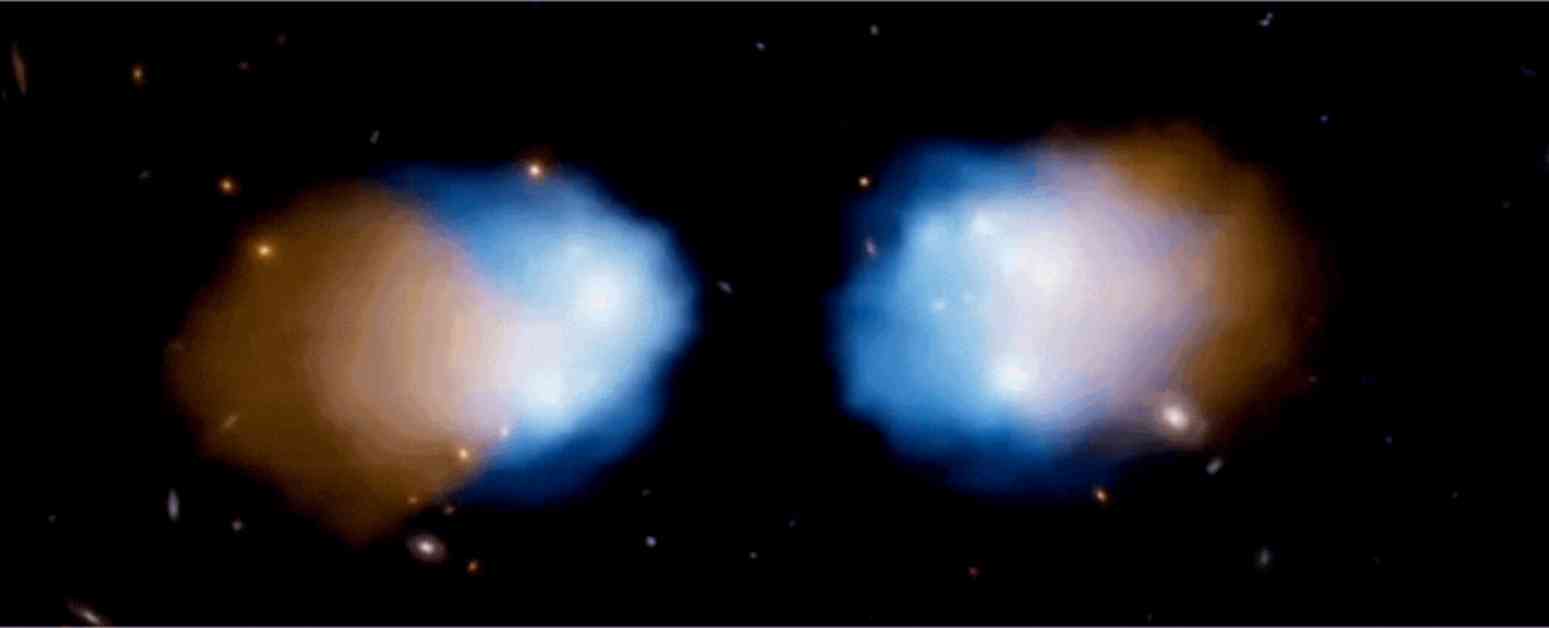Astronomers Witness Epic Galaxy Cluster Collision: Dark Matter Goes Rogue
In a groundbreaking observation, astronomers have witnessed two giant clusters of galaxies in the midst of a collision of epic proportions. This collision is so intense that the dark matter within the clusters has detached from normal matter and surged ahead, leaving a trail of mystery and intrigue in its wake.
Dark matter, the elusive substance that makes up a significant portion of the Universe’s mass, has long baffled scientists due to its invisible and undetectable nature. While we cannot directly observe dark matter, its presence is evident through the gravitational effects it exerts on visible matter such as stars and galaxies.
The collision between these galaxy clusters, collectively known as MACS J0018.5+1626, offers a unique opportunity for scientists to study the behavior and properties of dark matter in a new light. By observing how dark matter interacts with normal matter during this collision, researchers hope to glean valuable insights into the enigmatic substance that dominates the cosmos.
Decoupling of Dark Matter and Normal Matter
One of the most remarkable aspects of this galaxy cluster collision is the decoupling of dark matter from normal matter. Just like untethered cargo during a vehicular collision, the dark matter within the clusters has broken free from the constraints of normal matter and forged ahead independently.
While normal matter within the clusters experiences braking effects due to electromagnetic interactions, dark matter remains unaffected and continues on its trajectory. This uncoupling phenomenon offers a rare glimpse into the distinct behavior of dark matter compared to ordinary matter, shedding light on its unique properties and interactions.
The Velocity Divide: Dark Matter vs. Normal Matter
To study the velocities of dark matter and normal matter within the colliding galaxy clusters, researchers employed a variety of techniques to measure the speeds of each component. By analyzing the motion of galaxies within the clusters through the Doppler shift effect, scientists were able to estimate the velocity of dark matter based on the movement of these galactic structures.
In addition, the researchers utilized the Sunyaev-Zeldovich effect to measure the speed of the intracluster medium, providing insights into the velocity of normal matter within the clusters. By comparing the velocities of dark matter and normal matter, scientists were able to uncover significant differences in their behavior during the collision.
Through these meticulous observations and calculations, researchers have embarked on a journey to unravel the mysteries of dark matter and its role in shaping the cosmic landscape. By probing the dynamics of dark matter in the context of galaxy cluster collisions, scientists are inching closer to understanding the fundamental nature of this elusive substance.
Implications for Dark Matter Research
The findings from the collision of MACS J0018.5+1626 have profound implications for the field of dark matter research. By witnessing the decoupling of dark matter from normal matter in real-time, scientists have gained valuable insights into the behavior of this mysterious substance on a cosmic scale.
“This study is a starting point to more detailed studies into the nature of dark matter,” says lead researcher Silich. “We have a new type of direct probe that shows how dark matter behaves differently from normal matter.” The ability to directly observe the interactions between dark matter and normal matter during a galaxy cluster collision opens up new avenues for investigating the properties of dark matter and its role in the Universe.
As researchers delve deeper into the intricacies of dark matter dynamics, they hope to unlock the secrets of this enigmatic substance and shed light on its fundamental properties. By combining observational data with theoretical models, scientists aim to paint a comprehensive picture of dark matter and its influence on the cosmos.
Subheadings:
Unveiling the Mysteries of Dark Matter
The collision of galaxy clusters offers a unique opportunity to study the behavior and properties of dark matter on a grand scale. By observing how dark matter interacts with normal matter during the collision, researchers hope to gain valuable insights into the elusive substance that shapes the Universe.
The Decoupling of Dark Matter and Normal Matter
One of the most intriguing aspects of the galaxy cluster collision is the detachment of dark matter from normal matter. While normal matter experiences braking effects during the collision, dark matter remains unaffected and continues on its trajectory independently. This decoupling phenomenon provides a rare glimpse into the distinct behavior of dark matter compared to ordinary matter.
Implications for Dark Matter Research
The findings from the collision of MACS J0018.5+1626 have far-reaching implications for the field of dark matter research. By witnessing the decoupling of dark matter from normal matter in real-time, scientists have gained valuable insights into the behavior of this mysterious substance. Through continued study and analysis, researchers aim to unravel the mysteries of dark matter and its role in shaping the cosmic landscape.













